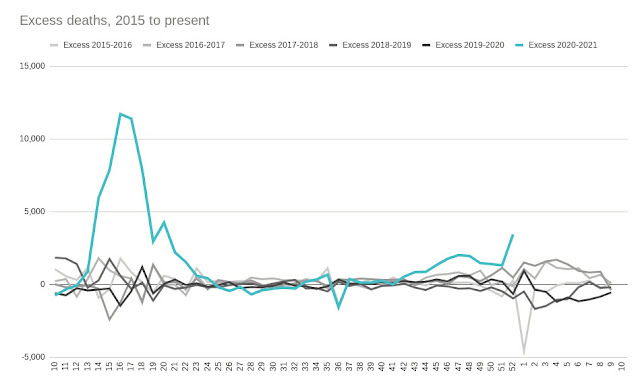Climate Change - some comparisons
Ice Ages are bad - especially if you live in Europe. The Ice Sheet can reach all the way down to Africa.
But the difference between an Ice Age and now? 4degC (7degF).
It took 10,000 years to get from the last Ice Age to the 1950s, i.e. change the global temp by 4degC. It’s taken 70 years to change the climate by over 1degC.
We’re changing the climate 2,750 faster than old Mother Nature does.
So, if an Ice Age that coats all of Europe in ice is only 4degC away in one direction, then what sort of world is 4degC away in the other direction?
Another way to think about it: 10degC (18degF) is the difference between Alaska and Florida.
Another way to think about it: humans are used to thinking in terms of linear change. Make a little change, have a little effect. Tap the accelerator gently, the car moves a bit quicker. Floor it, and the car goes much faster. Same with tapping the brakes, and stomping on the brakes.
But climate is a bit different. If we do a bit of climate damage, eventually we hit a point when the Earth’s systems start doing major self-harm, which makes things even worse, which starts new cycles of self harm, which.... etc.
The four biggest cycles I can think of off the top of my head are:
1) Earth gets hotter, ice caps and glaciers melt. This makes the Earth less shiny and reflective. So the Earth gets even hotter.
2) Earth gets hotter, and the warmer atmosphere holds more water vapour (i.e. is more humid). Water vapour is a powerful greenhouse gas. So the Earth gets even hotter. Which means the air holds even more water vapour, which... etc.
3) Earth gets hotter, so more of the permafrost melts. This belches huge amounts of methane into the atmosphere. Methane is 60 times more powerful than CO2 as a greenhouse gas, so the Earth gets warmer. So more of the permafrost melts, and releases more methane, which... etc.
4) Earth gets hotter, so the seas get warmer, and also shallower around places where there used to be ice caps (Counter-intuitive, but ice caps are massive enough to create their own gravity fields, so the sea is a little deeper near them). Methane ices frozen under pressure in the cold of the sea depths melt in the warmer, shallower sea, and bubbles up into the atmosphere. Methane is 60 times more powerful than CO2 as a greenhouse gas, so the Earth gets warmer. So more of the methane ices melt, and release more methane, which... etc.
But the difference between an Ice Age and now? 4degC (7degF).
It took 10,000 years to get from the last Ice Age to the 1950s, i.e. change the global temp by 4degC. It’s taken 70 years to change the climate by over 1degC.
We’re changing the climate 2,750 faster than old Mother Nature does.
So, if an Ice Age that coats all of Europe in ice is only 4degC away in one direction, then what sort of world is 4degC away in the other direction?
Another way to think about it: 10degC (18degF) is the difference between Alaska and Florida.
Another way to think about it: humans are used to thinking in terms of linear change. Make a little change, have a little effect. Tap the accelerator gently, the car moves a bit quicker. Floor it, and the car goes much faster. Same with tapping the brakes, and stomping on the brakes.
But climate is a bit different. If we do a bit of climate damage, eventually we hit a point when the Earth’s systems start doing major self-harm, which makes things even worse, which starts new cycles of self harm, which.... etc.
The four biggest cycles I can think of off the top of my head are:
1) Earth gets hotter, ice caps and glaciers melt. This makes the Earth less shiny and reflective. So the Earth gets even hotter.
2) Earth gets hotter, and the warmer atmosphere holds more water vapour (i.e. is more humid). Water vapour is a powerful greenhouse gas. So the Earth gets even hotter. Which means the air holds even more water vapour, which... etc.
3) Earth gets hotter, so more of the permafrost melts. This belches huge amounts of methane into the atmosphere. Methane is 60 times more powerful than CO2 as a greenhouse gas, so the Earth gets warmer. So more of the permafrost melts, and releases more methane, which... etc.
4) Earth gets hotter, so the seas get warmer, and also shallower around places where there used to be ice caps (Counter-intuitive, but ice caps are massive enough to create their own gravity fields, so the sea is a little deeper near them). Methane ices frozen under pressure in the cold of the sea depths melt in the warmer, shallower sea, and bubbles up into the atmosphere. Methane is 60 times more powerful than CO2 as a greenhouse gas, so the Earth gets warmer. So more of the methane ices melt, and release more methane, which... etc.
Bottom line - changes lead to runaway changes. And we don’t know exactly how much headroom we have before the runaway changes 3) and 4) kick in. (Runaway change 1) has already kicked in, and runaway change 2) is probably starting to kick in. And the permafrost has started to melt, so runaway change no. 3) has also started to kick in. So, well, actually, we already have a handle on a lot of it).
But we need to get a better handle on it all. And we need to start putting the genii back in the bottle.


Comments
Post a Comment